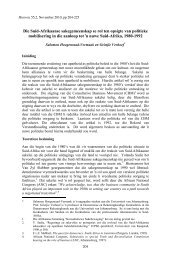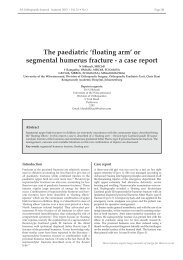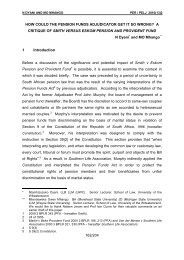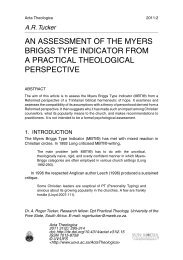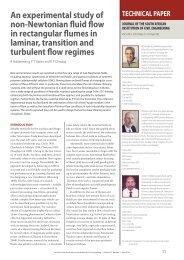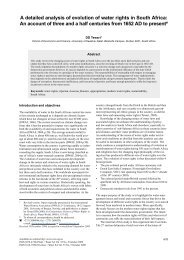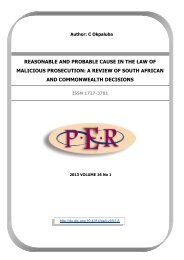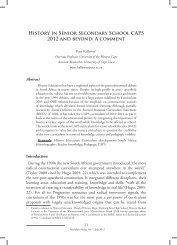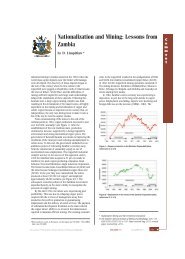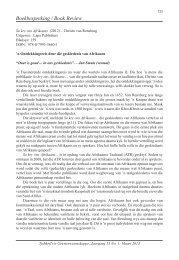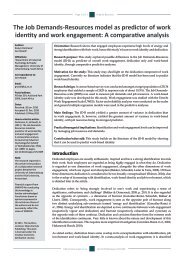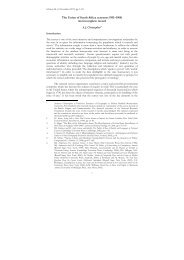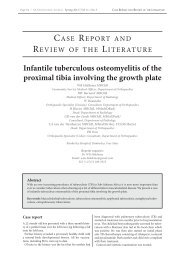TITLE OF ARTICLE: IN BOLD, ALL CAPS, CENTERED
TITLE OF ARTICLE: IN BOLD, ALL CAPS, CENTERED
TITLE OF ARTICLE: IN BOLD, ALL CAPS, CENTERED
Create successful ePaper yourself
Turn your PDF publications into a flip-book with our unique Google optimized e-Paper software.
TOUR CONSTRUCTION HEURISTICS FOR AN ORDER SEQUENC<strong>IN</strong>G PROBLEM<br />
A.P. de Villiers 1 , J. Matthews 2 & S.E. Visagie 3 *<br />
1, 2, 3<br />
Department of Logistics<br />
Stellenbosch University, South Africa<br />
1<br />
14812673@sun.ac.za, 2 14885054@sun.ac.za, 3 svisagie@sun.ac.za<br />
ABSTRACT<br />
An order picking system that requires pickers to move in a clockwise direction around a<br />
picking line with fixed locations is considered. The problem is divided into three tiers. The<br />
tier in which orders must be sequenced is addressed. Eight tour construction heuristics are<br />
developed and implemented for an order picking system operating in unidirectional picking<br />
lines. Two classes of tour construction heuristics – the tour construction starting position<br />
(TCS) and the tour construction ending position (TCE) – are developed to sequence orders in<br />
a picking line. All algorithms are tested and compared using real life data sets. The best<br />
solution quality was obtained by a TCE heuristic with adaptations.<br />
OPSOMM<strong>IN</strong>G<br />
’n Stelsel vir die opmaak van bestellings word ondersoek. Die stelsel vereis dat die werkers<br />
in ’n kloksgewyse rigting om ’n uitsoeklyn beweeg. Die probleem is verdeel in drie vlakke<br />
van besluite. Die besluit wat handel oor die volgorde waarin bestellings opgemaak word,<br />
word ondersoek. Agt toer-konstruksie-heuristieke is ontwikkel en geïmplementeer waarin<br />
die bestellings in ’n eenrigting uitsoeklyn opgemaak word. Twee klasse toer-konstruksieheuristieke<br />
– die toer-konstruksie-beginposisie (TCS) en die toer-konstruksie-eindposisie<br />
(TCE) – is ontwikkel om die volgorde van bestellings in ’n uitsoeklyn te bepaal. Al die<br />
algoritmes word getoets en vergelyk vir werklike datastelle. Die beste oplossingskwaliteit is<br />
verkry deur ’n TCE-heuristiek met aanpassings.<br />
A<br />
A<br />
A<br />
A<br />
A<br />
A<br />
A<br />
A<br />
A<br />
A<br />
A<br />
A<br />
A<br />
A<br />
A<br />
A<br />
A<br />
A<br />
A<br />
a<br />
1 The author is enrolled for a PhD (Operations Research) degree in the Department of<br />
Logistics, Stellenbosch University.<br />
2 The author is enrolled for a PhD (Operations Research) degree in the Department of<br />
Logistics, Stellenbosch University.<br />
* Corresponding author.<br />
South African Journal of Industrial Engineering, November 2012, Vol 23 (2): pp 56 -67
1. BACKGROUND AND <strong>IN</strong>TRODUCTION<br />
Order picking is known to be the most important activity in distribution centres (DCs) [19].<br />
It involves the process of retrieving products from storage (or buffer areas) in response to a<br />
specific customer request [3]. Usually, more than one order picking system is used in a DC.<br />
These order picking systems may be fully automated or operated by humans, but most<br />
systems employ humans as order pickers. In a typical DC, about 65% of operating expenses<br />
are consumed by order picking [15]. The organisation of order picking operations impacts<br />
on the DC’s performance, and therefore also on that of the supply chain [3]. DC design,<br />
storage assignment, and picker route planning may be used to enhance operating efficiency<br />
and space utilisation to reduce order picking costs [9].<br />
The order picking system in a DC owned by Pep Stores Ltd (‘Pep’), located in South Africa,<br />
is considered in this paper. Pep is a chain store operating more than 1,500 branches. Pep<br />
specialises in clothing but also sells other products, including home accessories and cellular<br />
phones. Orders processed by the DC are requests for specific branches. An order for a retail<br />
outlet is a set of products, together with the quantity of each product required by that<br />
retail outlet. The size of the products has a direct impact on the picking system used by<br />
Pep.<br />
The DC uses an order picking system that is based on the concept of a wave. A wave may be<br />
described as the set of stock keeping units (SKUs) in conjunction with the set of branches<br />
requiring at least one of the SKUs. All the orders for that wave are picked as a single<br />
operation. All the SKUs in a wave are therefore completely picked for all branches during<br />
that wave.<br />
To pick each wave, the DC uses a picking line. Figure 1 is a schematic representation of a<br />
typical picking line used in the DC. An SKU is stored in a single location, and only SKUs<br />
within the same wave may be stored on the same picking line. Pickers move in a clockwise<br />
direction around the conveyor belt, picking the required SKUs for each order.<br />
Figure 1: A schematic representation of the physical layout of a picking line containing<br />
m locations<br />
A voice-automated software system is used to communicate instructions to the pickers. This<br />
system directs each picker to the required locations for a single order. Once a picker has<br />
picked all the SKUs in an order, the voice-automated software system will direct the picker<br />
to the closest required SKU for a new order. The system ensures that a picker will complete<br />
all the picks for a single order before starting a new order. This system ensures that pickers<br />
pick orders sequentially.<br />
Each day picking lines are identified that will become available for waves during that<br />
specific day. SKUs are then identified and grouped in the waves scheduled for the available<br />
57
picking lines. A first-in-first-out (FIFO) policy is used to determine the SKUs that have to be<br />
scheduled. The set of SKUs in a wave are then assigned to the available picking lines. Once<br />
all the SKUs to be placed in a picking line are known, they are assigned specific locations<br />
based on in-house guidelines. When the picking line becomes available, each SKU is<br />
retrieved from storage and placed in its designated location. Once all the SKUs have been<br />
placed, order picking may begin.<br />
The planning of picking lines may be divided into three tiers of decisions. The first tier<br />
determines which SKUs should be allocated to which picking line. The problem of assigning<br />
scheduled SKUs to available picking lines is referred to as the ‘SKU to Picking Line<br />
Assignment Problem’ (SPLAP). The second tier, known as the ‘SKU to Location Problem’<br />
(SLP), considers the positioning of the various SKUs in a picking line. The final tier considers<br />
the sequencing of the orders for pickers within a picking line, and is referred to as the<br />
‘Order Sequencing Problem’ (OSP). All of these subproblems aim to achieve the objective of<br />
picking all the orders in the shortest possible time.<br />
The decisions associated with each tier are made sequentially during the planning of a<br />
picking line. First it has to be decided which SKUs are assigned to which picking lines; then<br />
each SKU has to be assigned to a specific location in the picking line; and finally the<br />
sequence in which the orders should be picked must be determined.<br />
Each subproblem therefore relies on the information generated by its predecessor. Thus, to<br />
solve a subproblem the solution to the successive subproblem must be known. For example,<br />
to evaluate a candidate solution for an instance of the SLP, the optimum sequencing of<br />
orders generated by the OSP is required. Due to this exchange of information between<br />
subproblems, the first subproblem which needs to be solved is the OSP. Any alteration in<br />
the SLP or the SPLAP will influence the OSP. Since the OSP must be tested repetitively for<br />
various alterations to the SLP or SPLAP, the OSP has to be solved quickly to avoid incurring<br />
significantly high overall computational times.<br />
2. THE OSP<br />
The OSP may be described as the sequencing of all the orders, for each picker, given a<br />
wave of SKUs assigned to distinct locations in a picking line, such that the total picking time<br />
is minimised.<br />
Each order requires a number of distinct SKUs in various amounts. A picker must visit each<br />
location containing the SKUs required by that order and collect for each SKU the requested<br />
number of units of that SKU. A picker may only start a new order once all the SKUs have<br />
been collected from the current order. Pickers are required to move in a clockwise<br />
direction when collecting SKUs.<br />
The following assumptions are derived from consultation with Pep’s DC management and<br />
from the assumptions of Matthews & Visagie [11].<br />
1. A picker must complete an entire order before starting another. The next order<br />
may not start at the same location where the previous order ended.<br />
2. The time taken physically to pick an SKU is constant with regard to all the orders.<br />
3. A picker walks at a more-or-less constant speed.<br />
4. An order may start at any location, and will finish at the last location where an<br />
SKU is picked for that order.<br />
5. The time required to switch to the next order is negligible.<br />
Given these assumptions, the OSP may be viewed as an equality-generalised travelling<br />
salesman problem (E-GTSP). The E-GTSP partitions nodes into clusters, and the problem<br />
calls for a minimum cost cycle visiting exactly one node in each cluster [5]. The E-GTSP is<br />
an NP-hard problem [8].<br />
58
If a cluster is defined as all possible starting positions associated with an order, each order<br />
(cluster) must be followed by another order (cluster). Additionally only a single starting<br />
location (node) in each order (cluster) must be selected.<br />
Let the duple (i, l) represent order l starting at location i. Let N be a set of all duples (i, l)<br />
and I 1 I 2 , … , I m a proper partition of the set N, where I l = {(1, l), (2, l), … , (m, l)}, if m<br />
locations are present on a single picking line. The set N may be interpreted as the vertices<br />
on a digraph, with edges representing the distance in number of locations between orders.<br />
The time needed to pick a product from a location is considered to be constant. The time<br />
needed to travel between orders and locations is considered to be variable. Thus the<br />
objective is to sequence a set of orders in such a way as to minimise the total distance<br />
travelled, and therefore the total travel time, to complete all the orders.<br />
Following the formulation by De Villiers & Visagie [4], let<br />
and<br />
p k<br />
f(x) = 1, if order k starting at location i is followed by order l<br />
0, otherwise<br />
be the position of order k within the order sequence.<br />
The following parameters are set in the model. Let<br />
n<br />
be the total number of order,<br />
m<br />
be the total number of locations,<br />
d ik<br />
be the number of locations which must be passed to complete<br />
order k starting at location i and<br />
e ijk =<br />
1, if orderk starting at location i is completed at location j<br />
<br />
0, otherwise<br />
The objective is then to<br />
subject to<br />
m<br />
m<br />
minimise d ik x ikl<br />
m<br />
n<br />
n<br />
i=1 k=1 l=1<br />
m<br />
n<br />
x ikl = 1<br />
i=1 l=1<br />
m n<br />
x ikl = 1<br />
i=1 k=1<br />
m<br />
n<br />
x i1l = 0<br />
i=2<br />
x ikl − x pqk e pqi ≤ 0<br />
l=1<br />
p=1 q=1<br />
(1)<br />
l = 1, … , n, (2)<br />
k = 1, … , n, (3)<br />
l = 1, … , n, (4)<br />
i = 1, … , m,<br />
<br />
k = 1, … , n,<br />
p 1 = 1, (6)<br />
m<br />
p k − p l + n x ikl ≤ n − 1<br />
k = 1, … , n,<br />
<br />
l = 2, … , n,<br />
(7)<br />
i=1<br />
(5)<br />
x ikl ∈ {0,1}<br />
i = 1, … , m,<br />
k = 1, … , n,<br />
(8)<br />
l = 1, … , n,<br />
p k ≥ 0 k = 1, … , n, (9)<br />
59
The objective function (1) minimises the total distance travelled by a picker. Constraint<br />
sets (2) and (3) ensure that each order is completed only once. Constraint sets (4) and (6)<br />
ensure that the first order (which is a dummy order) is completed first and that it starts at<br />
location 1. Constraint set (5) ensures that if order k starts at location i then the order that<br />
precedes order k will end at location i. For example, if order k (starting at location i)<br />
follows order q (starting at location p), then order q should end at location i. Therefore if<br />
x ikl equals 1 then both e pqi and x pqk should also equal 1. Constraint set (7) follows from the<br />
standard MTZ constraints [14]. It ensures that no subtours are generated. Subtours will<br />
occur if at least two subsets of orders form their own closed pick sequences. One closed<br />
pick sequence containing all the orders must be determined. The size of this formulation is<br />
n 2 m + n variables (of which n 2 m are binary) and n 2 + 2n + nm constraints. For a typical<br />
real life instance n ≈ 1 200 and m ≈ 56, yielding a number of variables in excess of 8 × 10 7<br />
and a number of constraints in excess of 1,5 × 10 6 , which renders an exact approach<br />
impossible.<br />
Matthews & Visagie [11] suggested a maximal cut approach to solve this problem. This<br />
approach always leads to a solution within one picking cycle of a lower bound to the<br />
problem. However, the computational times for a typical real life instance of the model are<br />
more than five minutes if solved on an Intel® Core TM 2 Duo 3GHz with 3.7 GB RAM running<br />
Windows XP [18] using Lingo 11 [12]. The computational time for this approach is too long<br />
for use in solving the SLP where many different SKU locations must be tested. Faster<br />
approaches are therefore required to solve the OSP in less computational time. In the next<br />
section, a short section on heuristic approaches in general is presented. However, this<br />
paper focuses on tour construction heuristics to solve the OSP in much shorter times, while<br />
maintaining reasonable solution quality.<br />
3. HEURTISTICS FOR TSPs<br />
TSP heuristics are typically classified into three types: tour construction heuristics, tour<br />
improvement heuristics, and randomised improvement heuristics. Combinations of these<br />
approaches are also found in the literature [6]. Typical tour construction heuristics include<br />
the nearest neighbour heuristic, the family of insertion heuristic, Clark and Wright savings<br />
heuristic, the minimal spanning tree heuristic, and Christofides’ heuristic [6,7]. Tour<br />
improvement heuristics take a feasible solution to the TSP and improve on that solution by<br />
locally changing the sequence in which nodes are visited. A well-known tour improvement<br />
heuristic is the k-opt method, which replaces k arcs in the solution by another set of k arcs<br />
that will result in a better solution [1]. Most randomised tour improvement heuristics arise<br />
from the subject of metaheuristics, which includes algorithms like tabu search, simulated<br />
annealing, genetic algorithms, and ant colony optimisation to solve TSPs [2].<br />
The OSP presented here is not well suited to tour improvement or randomised improvement<br />
heuristics, nor even to a combination of these methods. Both of these approaches start with<br />
a current tour and attempt to improve on it by performing local changes to it. The<br />
structure of the OSP limits the use of tour improvement heuristics, as a change in the<br />
ending position of an order may effect all starting and ending positions (and thus pick<br />
distances) of subsequent orders in the sequence. Therefore, by changing the sequence in<br />
which a subset of orders is picked, the quality of the sequence of orders that follows this<br />
changed subset also changes. This characteristic is illustrated by an example picking line<br />
with ten locations and four orders. Figure 2 (a) illustrates the order sequence (A, B, C, D, E)<br />
with a total pick length of 32 locations. The individual pick lengths of each order are also<br />
given. If the sequence is changed by moving order D to the start of the sequence, as shown<br />
in Figure 2 (b), both orders A and D will have shorter pick lengths, implying a local<br />
improvement on orders A and D. The end location of order A is changed, however, and the<br />
pick lengths for orders C and D have now increased, resulting in a longer total pick<br />
distance. Although only one order was moved in the sequence (it is a local change) the pick<br />
lengths for all the following orders changed. Therefore only tour construction heuristics<br />
that add on orders at the end of the sequence are suitable for this variant of the TSP.<br />
60
Experiments with real life data confirm that the problem shown in the example above holds<br />
in general. Tour improvement heuristics and randomised improvement heuristics yield<br />
substantially inferior results to tour construction heuristics, and are thus not considered<br />
further in this paper.<br />
Figure 2: An example of a picking line with ten locations and four orders. A letter in a<br />
location indicates that a specific order require SKUs from that location.<br />
4. TOUR CONSTRUCTION APPROACHES<br />
The general framework of tour construction heuristics has been adapted to take the<br />
structure of the problem into account. To explain the approaches presented here, a number<br />
of definitions are required [11].<br />
Let a span of an order be the smallest set of locations passed to pick the entire order, given<br />
a starting location. A span for an order k starting at location i may be represented by<br />
S k i = 〈i, e k i 〉, where i is the starting location and e k<br />
i<br />
the closest ending location of order k.<br />
Any starting location for an order has a unique span associated with it, since an order must<br />
be completed once it is started.<br />
Let the size of a span be the number of locations traversed to complete the order picked on<br />
that span. Each order may be assigned a starting point from all the possible locations within<br />
i<br />
a picking line. The size of a span S k for an order k may be represented by:<br />
S i k = 〈i, e i k<br />
〉 = e k i i<br />
− i if i < e k<br />
m + e i i<br />
k − i if i ≥ e k<br />
where m is the total number of locations. Consider the example in Figure 3, where order k<br />
requires SKUs from locations 9, 12 and 16. If a picker who is currently at location 6 is<br />
assigned order k he will traverse a distance of S 6 k = |〈6,16〉| = 10 locations and end at<br />
location 16. The locations traversed by the picker are indicated by the thick dashed line in<br />
Figure 3. Furthermore, let P k be the number of different SKUs that are required by order k.<br />
For the example in Figure 3, three SKUs are picked in order k, resulting in P k = 3.<br />
Let the minimum span S k<br />
min<br />
of an order be a span of smallest size for an order. From the<br />
example in Figure 3, S k min = |〈9,16〉| = 7.<br />
The tour construction heuristics presented here attempt to assign a desirable order to a<br />
picker when he/she finishes his/her current order. The influence of this assignment on the<br />
sequence of future orders is not considered.<br />
61
Figure 3: A schematic representation of the layout of a picking line containing 20<br />
locations. The squares indicates the SKUs that are requested by an order k.<br />
4.1 Tour construction starting heuristic<br />
The tour construction starting heuristic (TCS) considers the starting location of preferable<br />
orders. If any orders require an SKU from the current location of the picker, only these<br />
orders are considered. The order with the shortest span is then selected for picking. When<br />
the picker has completed the order, the current location of the picker is updated<br />
accordingly.<br />
If, however, no orders require an SKU at the current location, the current location is<br />
incremented by one until an order is found that does require an SKU from the current<br />
location. This process is repeated iteratively until all orders are picked. The general<br />
framework of the TCS is given in Algorithm 1.<br />
Algorithm 1: Tour construction starting heuristic (TCS)<br />
The TCS therefore determines the next order, k, to be picked from location i as<br />
k = arg min<br />
k∈R i<br />
S k i , (10)<br />
where R i is the set of orders, not yet completed, that have to be picked from location i. If<br />
R i = ∅, the current location i is increased by one. The nearest order may be interpreted as<br />
the order that may be completed within the smallest number of locations from the current<br />
location.<br />
4.2 Tour construction ending heuristic<br />
The tour construction ending heuristic (TCE) considers the end location of pending orders if<br />
started at the current location of picker i. The spans of all pending orders starting at<br />
location i are used as a measure, and the order with the shortest span is selected. The<br />
general framework of the TCE is given in Algorithm 2.<br />
62
Algorithm 2: Tour construction ending heuristic (TCE)<br />
The next order in the TCE is determined as<br />
k = arg min<br />
k∈U S k i , (11)<br />
where U is the set of uncompleted orders. The TCE heuristic essentially considers all<br />
uncompleted orders, whereas the TCS considers only a subset of these for selection.<br />
4.3 Results of the tour construction heuristic approaches<br />
To evaluate the proposed tour construction heuristics, 22 real-life data sets were received<br />
from Pep. The heuristics were compared with a lower bound obtained by the maximal cut<br />
approach described by Matthews & Visagie [11]. All the algorithms were tested using an<br />
Intel® Core TM 2Duo 3 GHz with 3.7 GB RAM running Linux Ubuntu 9.10 [17] using Java [16].<br />
The average time for solving an instance by means of the maximal cut approach is about<br />
five minutes. Both the heuristics were tested, and all computation times were significantly<br />
less than one second, which is significantly lower than the maximal cut approach.<br />
The data sets were divided into three groups: large, medium, and small. Large data sets<br />
have more than 1,000 orders, medium data sets contain between 200 and 1,000 orders, and<br />
small data sets less than 200 orders. Table 1 displays the results for the various heuristics,<br />
as well as the lower bound.<br />
The TCS outperformed the TCE for the large data sets. The TCE, however, outperforms the<br />
TCS for the medium and small data sets.<br />
Table 1: Results obtained from the TCS and TCE used to solve several OSP instances.<br />
The solutions are displayed as the number of cycles traversed to pick all the orders. The best<br />
performing heuristic for each data set is indicated in boldface. The size – that is, number of orders<br />
(O) and locations (L) – is displayed for each data set.<br />
63
5. TOUR CONSTRUCTION HEURISTIC ADAPTATIONS<br />
Focusing solely on spans as a way to distinguish between desirable orders may be<br />
inadequate. This is illustrated by an example, shown in Figure 4, with a picking line<br />
containing two orders: order k (indicated by squares) and order l (indicated by triangles).<br />
Figure 4: A schematic representation of the layout of a picking line containing 20<br />
locations.<br />
The squares indicate the SKUs that are requested by an order k, where triangles indicate the SKUs<br />
that are required by an order l.<br />
Consider a picker currently positioned at location 4. Either order k or order l may be<br />
picked. There is no preference between the two orders as S 4 k = S 4 l = |〈4,16〉| = 12. The<br />
minimum span of order k, however, is S 4 k . In this situation it may be more desirable to pick<br />
order k, as the picker is able to pick it on its minimum span, leaving order l for a later<br />
opportunity when the picker might pick order l on a shorter span too. In the next section,<br />
adaptations of the TCS and TCE are introduced to address this situation.<br />
5.1 Minimum span adaptations<br />
In an effort to assign preference to picking orders on their minimum spans, the length of a<br />
proposed span of an order is compared with the length of its minimum span. Both the TCS<br />
and the TCE were adapted with this variation (TCS 1 and TCE 1 ). Let the TCS 1 determine the<br />
next order k to be picked, given a current location $i$, to be sequenced as<br />
S i k <br />
k = arg min<br />
k∈R i S min k .<br />
If S i k S min k the pick-length of order k is at a minimum. Similarly, the next order k<br />
sequenced in the TCE 1 given a current location i is determined as<br />
k = arg min<br />
k∈U<br />
S i k <br />
S min k .<br />
5.2 Pick density adaptations<br />
A situation may arise where multiple orders have identical spans given a starting location,<br />
but the number of picks may differ. This variation uses a similar approach to TCS 1 and<br />
TCE 1 , but considers the number of picks in an order instead of the minimum span. Let the<br />
TCS 2 heuristic determine the next order k to be picked to be<br />
S i k <br />
k = arg min ,<br />
k∈R i P k<br />
where i is the current location and P k is the number of picks in order k. If S i k ⁄ P k the picklength<br />
of order k is at a minimum and there is a pick at each location on the minimum<br />
span. The next order in the TCE 2 heuristic is determined as<br />
S i k <br />
k = arg min .<br />
k∈U P k<br />
64
5.3 Combined relative measures<br />
A final approach is considered where the combined influences of the relative measures are<br />
used. This variation combines the relative measures of considering the minimum span of an<br />
order, as well as the number of picks in an order. Let the TCS 3 heuristic determine the next<br />
order k to be picked as<br />
S i k <br />
k = arg min<br />
k∈R i S min .<br />
k ∙ P k<br />
The next order in the TCE 3 heuristic is determined as<br />
S i k <br />
k = arg min<br />
k∈U S min .<br />
k ∙ P k<br />
This variation considers both the minimum span and the number of possible starting<br />
locations for each order. An adaptation, where the denominator in TCS 3 and TCE 3 may be<br />
altered to the additive form, was also tested. This approach delivers similar results to the<br />
multiplicative case.<br />
5.4 Results of the adapted tour construction heuristic approaches<br />
Table 2 displays the results obtained for all the variations of the TCS and TCE heuristics<br />
used to solve the OSP. The TCE heuristic and its variations outperform the TCS heuristic and<br />
its variations. This may be attributed to the fact that the TCE heuristics consider a wider<br />
range of possible orders to be picked when selecting a following order.<br />
Table 2: Results obtained from all the variations of the TCS and TCE heuristics used to<br />
solve the OSP.<br />
A total of 22 real-life data sets are considered where the number of orders (O) and locations (L)<br />
are displayed for each data set. The solutions displayed in bold type indicate the best-performing<br />
heuristic for each data set.<br />
Table 3 displays the computational times for all the tour construction heuristics considered<br />
in this paper. The computational times are given in milliseconds.<br />
In an effort to compare algorithms over multiple data sets, the results of each algorithm<br />
were normalised relative to the lower bound. The data were normalised by dividing the<br />
number of cycles traversed by the lower bound. This normalisation establishes a relative<br />
measure by which algorithms may be compared. The normalised results for each size of<br />
data were then grouped as one sample of elements, and the testing was done to determine<br />
whether there were significant differences in the mean between the different algorithms.<br />
65
An overall level of significance in the form of a Bonferroni t-test was performed for the 22<br />
instances considered, to determine if the mean solution of one instance differs significantly<br />
between all possible pairs of instances. In the case where x instances are considered<br />
x = x(x − 1) ⁄ 2 two sample t-tests may be performed to test for significant difference<br />
2<br />
between all possible pairs of instances.<br />
Table 3: Computational times in milliseconds for all the variations of the TCS and TCE<br />
heuristics used to solve the OSP.<br />
A total of 22 real life data sets are considered where number of orders (O) and locations (L) are<br />
displayed for each data set.<br />
The Bonferroni method may overcome the problem of assigning an overall level of<br />
significance when considering a large number of t-tests. The confidence level is modified<br />
from α to 2α⁄ x(x − 1) for each of the t-tests. The confidence level then pertains to each of<br />
the x(x − 1) ⁄ 2 confidence intervals covering their respective differences of population<br />
means [10]. The confidence level helps to determine if statistically significant differences<br />
are large enough to be of practical importance.<br />
Table 4 shows the results obtained when a Bonferroni t-test was conducted on the<br />
performance of the average of the solution quality of each heuristic divided by the lower<br />
bound for each data set [10]. The different classes indicate that the means of various<br />
heuristics considered were significantly different for a Bonferroni multiple comparison test<br />
with p < 0.05.<br />
On average, the TCE 3 heuristic performs best for small data sets, while TCE 2 performs best<br />
for medium and large data sets. The TCS heuristics and its variations are comprehensively<br />
outperformed by the solutions of the TCE heuristic and its variations.<br />
6. CONCLUSION<br />
An order picking operation found in a DC owned by Pep Stores was investigated. Three tiers<br />
of problems were identified: the SPLAP, SLP, and OSP. Quick tour construction heuristics<br />
are required to solve the OSP, since the SLP and SPLAP can only be solved by repeatedly<br />
solving the OSP. Initially two classes of tour construction heuristics were introduced,<br />
followed by extensions of these heuristics. Computational results are presented that<br />
illustrate the improved performance when extending the original heuristics. The bestperforming<br />
heuristic is the TCE with relative measures. In particular, the TCE 2 achieved the<br />
best overall performance of the instances considered.<br />
66
Table 4: Results obtained from the Bonferroni t-test for small, medium and large data sets.<br />
The mean represents the average of the results obtained by the respective heuristics divided by<br />
the lower bound. The value of N indicates the number of observations considered for each class.<br />
REFERENCES<br />
[1] Barun, C., Karloff, H. & Tovey, C. 1999. New results on the old k-opt algorithm for the traveling<br />
salesman problem, Operations Research, 28(6), pp. 1998-2029.<br />
[2] Cheng, C.B. & Mao, C.P. 2007. A modified ant colony system for solving the travelling salesman<br />
problem with time windows, Mathematical and Computer Modelling, 46(9-10), pp. 1225-1235.<br />
[3] De Koster, R., Le-Duc, T. & Roodbergen, K.J. 2007. Design and control of warehouse order<br />
picking: A literature review, European Journal of Operational Research, 182(2), pp. 481-501.<br />
[4] De Villiers, A.P. & Visagie, S.E. 2011. Toewysingsheuristieke om die volgorde van bestellings vir<br />
’n uitsoeklyn te bepaal, Litnet Akademies, 9(1) pp. 1-22.<br />
[5] Fischetti, M., González, J.J.S. & Toth P. 1997. A branch-and-cut algorithm for the symmetric<br />
generalized traveling salesman problem, Operations Research, 45(3), pp. 378-394.<br />
[6] Gendreau, M., Hertz, A. & Laporte, G. 1992. New insertion and postoptimisation procedures for<br />
the traveling salesman problem, SIAM Journal on Computing, 40(6), pp. 1086-1094.<br />
[7] Johnson, D.S. & McGeoch, L.A. 2007. Experimental analysis of heuristics for the STSP, in Gutin,<br />
G. & Punnen, A.P. (eds), The traveling salesman problem and its variations, Springer, New York,<br />
pp. 369-443.<br />
[8] Gutin, G. & Yeo, A. 2003. Assignment problem based algorithms are impractical for the<br />
generalized TSP, Australasian Journal of Combinatorics, 27, pp. 149-153.<br />
[9] Hsieh, L. & Tsai, L. 2006. The optimum design of a warehouse system on order picking<br />
efficiency, The International Journal of Advanced Manufacturing Technology, 28(5-6), pp. 626-<br />
637.<br />
[10] Johnson, R.A. 2005. Miller & Freund’s probability and statistics for engineers, 7 th ed., Pearson<br />
Prentice Hall.<br />
[11] Matthews, J. & Visagie, S.E. 2011. Order sequencing on a unidirectional cyclical picking line,<br />
[Submitted].<br />
[12] Lindo Systems. 2011. Lingo 11. Retrieved March 2011 from www.lindo.com.<br />
[13] Litvak, N. & Vlasiou, M. 2009. A survey on performance analysis of warehouse carousel systems,<br />
(Unpublished) Technical Report, Department of Applied Mathematics, University of Twente,<br />
Twente.<br />
[14] Punnen, A.P. 2007. The traveling salesman problem: Applications, formulations and variations,<br />
in Gutin, G. & Punnen, A.P. (eds), The traveling salesman problem and its variations, Springer,<br />
New York, pp. 1-28.<br />
[15] Ruben, R.A. & Jacobs, F.R. 1999. Batch construction heuristics and storage assignment<br />
strategies for walk/ride and pick systems, Management Science, 45(4), pp. 575-596.<br />
[16] Sun Microsystems. 2011. Java. Retrieved June 2011 from http://java.sun.com.<br />
[17] Ubuntu. 2011. Retrieved March 2011 from www.ubuntu.com.<br />
[18] Microsoft. 2011. Windows XP. Retrieved March 2011 from www.microsoft.com.<br />
[19] Yu, M. & de Koster, R.B.M. 2009. The impact of order batching and picking area zoning on order<br />
picking system performance, European Journal of Operational Research, 198(2), pp. 480-490.<br />
67



